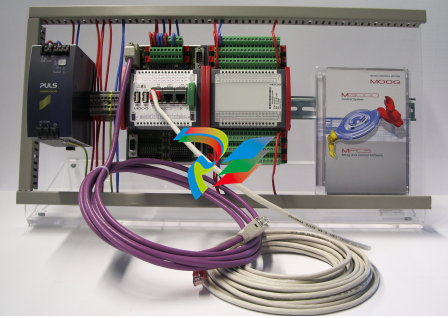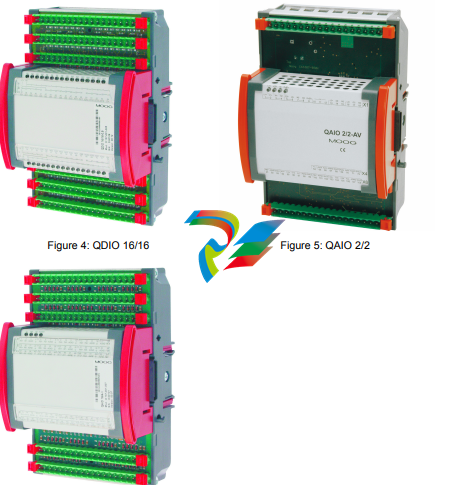
MOOGUser Manual M3000® Automation System MSC II (Moog Servo Controller)
• MACS HMI (Moog Axis Control Software Human Machine Interface)
Visualization package which can be run without MACS
Ö-"3.6.1-MACS HMI Visualization Package" on page 26
3.1 M3000® System Architecture
M3000® System
Architecture
The M3000® automation system has the hardware and software structure
necessary for modular and flexible automation solutions with distributed intelligence.
The MSC II control module can use an Ethernet connection (LAN, company Ethernet
network, peer-to-peer connection) to communicate with another controller,
development environment, or visualization package.
Ö-"7.1-Ethernet" on page 47
Ö-"10.5.1-Communication Between MSC II and MACS" on page 84
Ö-"10.5.1.1-Ethernet Communication Interface" on page 84
To create real time capable applications, even in distributed systems and to CAN Bus
give the application a better structure, M3000® can also be divided hierarchically.
Ö-"7.5-CAN Bus and CANopen" on page 55
WideCAN and LocalCAN are two equal, mutually independent CAN bus interfaces. In a typical application they are used as follows:
• WideCAN can be used for networking of individual control groups or re- WideCAN
mote modules. Usually, WideCAN is used for synchronization and data
exchange between the control groups and operating stations of a machine or system.
Ö-"3.3.4-R-Modules (Remote Modules)" on page 19
Ö-"7.7.4-WideCAN Bus Groups" on page 67
In addition, the WideCAN network can integrate other components with
a CAN bus or CANopen interface, such as motor controllers, hydraulic
valves, and radial piston pumps.
• LocalCAN connects the DIN rail modules within a LocalCAN bus group LocalCAN
and, if applicable, the QEBUS-CAN to the connected LocalCAN bus
groups or CAN sensors/actuators.
Ö-"3.3.3.2-QEBUS-CAN" on page 19
Ö-"7.7.3-LocalCAN Bus Groups" on page 66
The M3000® modules mentioned here represent only a part of Moog's
current product range. In addition to other M3000® modules, Moog's
product range includes a large variety of accessories.
Ö-"11-Product Range" on page 114

The MSC II starter kit is available in two versions:
• MSC II with Profibus-DP slave
• MSC II with dual EtherCAT master
It includes everything needed to get started:
• MSC II
• Power supply 24 V 10 A
• License key, green
• QDIO 16/16-0,5
• MACS development environment
• Software maintenance contract
• Crossed Ethernet interface cable, 10 m (10.94 yd)
• CAN bus interface cable, 3 m (3.28 yd)
• 6 Plug-in terminal strips with screw terminals, 18 pole
• 2 Plug-in terminal strip with screw terminals, 9 pole
• 4 Plug-in terminal strips with spring power clamp, 10 pole
The included DIN rail modules MSC II and QDIO are mounted (together with
the power supply) on a single mounting plate.
A suitable power cord is the only additional item required to facilitate connection to the power source.
3.3 M3000® Modules
3.3.1 MSC I
MSC I
Figure 2: MSC I Control Module
The MSC I digital control module is a fully programmable multi-axis controller.
The inputs and outputs of the MSC I can be extended locally by attaching
Q-modules. The MSC I and the attached modules then form an E-bus group.
MSC I and Q-modules within E-bus groups communicate over the internal
E-bus.
The MSC I is programmed and configured with the MACS development environment (complies with IEC 61131).
Ö-"3.5-Application Programs" on page 25
The M3000® modules mentioned here represent only a part of Moog's
current product range. In addition to other M3000® modules, Moog's
product range includes a large variety of accessories.
Ö-"11-Product Range" on page 114

3.3.2 MSC II

The MSC II digital control module is a fully programmable multi-axis controller.
The inputs and outputs of the MSC II can be extended locally by attaching
Q-modules. The MSC II and the attached modules then form an E-bus group.
MSC IIs and Q-modules within E-bus groups communicate over the internal
E-bus.
Ö-"7.7.2-E-Bus Groups" on page 65
The MSC II is programmed and configured with the MACS development environment (complies with IEC 61131).
Ö-"3.5-Application Programs" on page 25
3.3.3 Q-Modules
Q-Modules are I/O extension modules for MSC I and MSC II. Q-Modules
The following Q-modules are available from Moog:
• QDIO 16/16 (digital I/O extension module)
Ö-"3.3.3.1-QDIO and QAIO" on page 18
• QAIO 2/2 (analog I/O extension module)
Ö-"3.3.3.1-QDIO and QAIO" on page 18
• QAIO 16/4 (analog I/O extension module)
Ö-"3.3.3.1-QDIO and QAIO" on page 18
• QEBUS-CAN (CAN extension module)
Ö-"3.3.3.2-QEBUS-CAN" on page 19
Q-modules can be used only as E-bus slaves within E-bus groups.
Ö-"7.7.2-E-Bus Groups" on page 65
When using an RDIO as E-bus master, only QDIOs can be used as E-bus
slaves.
Ö-"7.6.2.1-E-Bus Master and E-Bus Slaves" on page 61
Detailed information about the MSC II:
Ö-"10-MSC II (Moog Servo Controller)" on page 72
Refer to the Q-modules' documentation for more detailed information
3.3.3.1 QDIO and QAIO

QDIO and QAIO I/O extension modules can be used to locally extend the inputs and outputs of an MSC I or MSC II. They have no internal intelligence.




























































































































